test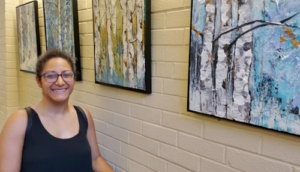 Nicole Simmons was hanging her artwork in Homeland’s sunny Florida Room Gallery when a resident came by.
Nicole Simmons was hanging her artwork in Homeland’s sunny Florida Room Gallery when a resident came by.
“Ooh, look at the pretty pictures,” the resident said. “They are so beautiful.”
That was music to Simmons’ ear. As a self-taught artist who recently discovered her love for painting, she loves connecting with people who express their appreciation.
“I like hearing that people get something out of it,” she said.
Simmons is the artist for the summer 2024 edition of the Community Gallery Initiative. Through the initiative, the Art Association of Harrisburg matches local artists with exhibit spaces at area businesses and facilities, rotating the exhibits quarterly.
Initially, Simmons thought she’d try painting as a new hobby. Five years after graduating from Gettysburg College with a degree in political science and a minor in Spanish, she became curious about the “paint and sip” trend.
“As soon as my brush hit the canvas, I thought, ‘This is awesome.’”
Initially, Simmons expected to work in cartooning and animation, but experienced artists suggested that she get a grounding in portraits and painting techniques first.
“So, I kind of went on a tangent, and I’ve been on that tangent ever since,” she said.
Today, Simmons works as a fundraising researcher and strategist at Dickinson College. Art is her creative expression outlet. She paints in a studio in her recently refurbished basement, experimenting with media and techniques.
Texture and subtle collage are evident in the pieces brightening the Homeland hallway. Her mixed-media pieces might blend plaster, collage, and acrylics. One painting of birch trees was created with oil paint and cold wax. for a cake-frosting look that inspired its title, “Frosty Twilight.”
Simmons primarily learned to paint from YouTube videos, online classes, and through the Art Association of Harrisburg.
For her Homeland show, Simmons brought two collections featuring butterflies and birch trees. The butterfly collection emerged from her memories of catching butterflies as a child. As she painted, she recognized that butterflies also represented her transformation into an artist.
“I chose butterflies as a fun thing to do, but after a while, I realized that butterflies have a deeper meaning for me,” she said. “They change. They’re metamorphosis.”
Hikes with her husband through the wilds of Pennsylvania and Colorado inspired her birch tree paintings.
“I love the visual texture of birch trees,” she said. “It resonated with what I was trying to do.”
While this is Simmons’ first Community Gallery Initiative showing, the Art Association of Harrisburg has included her paintings in group exhibits. She also had a solo show at the Wheel of Light studio in Halifax. Simmons sells her work at www.nicolesimmonsart.com
“I prefer putting out things that inspire happiness and joy in people,” she said. “Naturally, there’s a place in art for the more pensive pieces, and I appreciate them, but my creative process is so joyful and brings me a lot of satisfaction that I want to pass it on.”
Showing at Homeland feels like the perfect fit.
“I love bringing my work to this space,” she said. “Residents might see them and remember their own experiences, when they took a hike or were catching butterflies.”
As to where her art goes next, Simmons is “kind of at a crossroads.” She’s thinking of returning to portraitures but still loves playing with texture, so she’s trying to figure out how all the pieces fit.
“Lately, I’ve been inspired by light and shadow and how to render warm and cool light,” she said. “Color temperature and color theory is what I’ll dive into next.”
Learning always drives the look and feel of her work.
“Art is constantly a learning experience, and I think that’s part of why I love art so much,” Simmons said. “There’s always something to learn. People say I should be a professional artist, but I love being a learner and student. It’s so freeing to experiment and try things. You’re not beholden to the same style.”
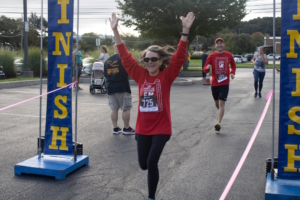 Homeland Hospice, a nonprofit outreach program of Homeland Center in Harrisburg, will host its 10th annual 5K and Memory Walk on Saturday, Sept. 14, at 8:30 a.m. at the Rossmoyne Business Center at 5000 Ritter Road in Mechanicsburg. The event serves to remember loved ones lost and raise funds to support those who need care today.
Homeland Hospice, a nonprofit outreach program of Homeland Center in Harrisburg, will host its 10th annual 5K and Memory Walk on Saturday, Sept. 14, at 8:30 a.m. at the Rossmoyne Business Center at 5000 Ritter Road in Mechanicsburg. The event serves to remember loved ones lost and raise funds to support those who need care today.
 Nicole Simmons was hanging her artwork in Homeland’s sunny Florida Room Gallery when a resident came by.
Nicole Simmons was hanging her artwork in Homeland’s sunny Florida Room Gallery when a resident came by.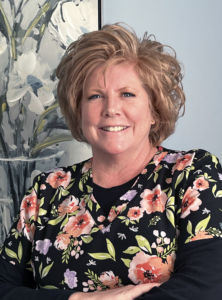 By Kristine Crockett, RN, CHPN, Director of Homeland Hospice and Homeland Palliative Care. Kristine has been providing compassionate end-of-life care as a hospice nurse for more than 25 years and provides a wealth of knowledge and experience to those she is leading as the director. Kristine is an Army Veteran having served in the military for over nine years as a military police and corrections officer. She enjoys spending time with her family and friends at gatherings and vacations on the lake, as well as helping out her staff and finding ways to support fellow Veterans whenever possible.
By Kristine Crockett, RN, CHPN, Director of Homeland Hospice and Homeland Palliative Care. Kristine has been providing compassionate end-of-life care as a hospice nurse for more than 25 years and provides a wealth of knowledge and experience to those she is leading as the director. Kristine is an Army Veteran having served in the military for over nine years as a military police and corrections officer. She enjoys spending time with her family and friends at gatherings and vacations on the lake, as well as helping out her staff and finding ways to support fellow Veterans whenever possible.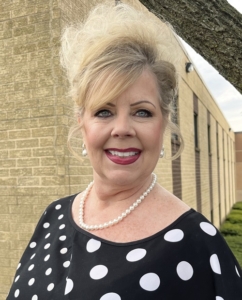 As a young woman, Tamara Jaroszewski of Harrisburg experienced the profound impact of hospice services when her sister died of breast cancer at age 40. For Tamara, hospice work became a beacon of hope and inspiration. She felt called to help patients during their end-of-life journey. Her call was recently answered when she joined Homeland’s Hospice team as the volunteer coordinator. Homeland Hospice, a nonprofit hospice program, serves communities throughout Central Pennsylvania.
As a young woman, Tamara Jaroszewski of Harrisburg experienced the profound impact of hospice services when her sister died of breast cancer at age 40. For Tamara, hospice work became a beacon of hope and inspiration. She felt called to help patients during their end-of-life journey. Her call was recently answered when she joined Homeland’s Hospice team as the volunteer coordinator. Homeland Hospice, a nonprofit hospice program, serves communities throughout Central Pennsylvania. A hallmark of a successful organization is its ability to evolve to meet the needs of its community. For more than 156 years, Homeland Center has structured its programming to meet the needs of its patients and their families. In 2022, Homeland started offering palliative care, a new and valuable outreach service, to provide a greater continuum of care for its patients. The addition of palliative care services helps patients with a serious illness have a better quality of life.
A hallmark of a successful organization is its ability to evolve to meet the needs of its community. For more than 156 years, Homeland Center has structured its programming to meet the needs of its patients and their families. In 2022, Homeland started offering palliative care, a new and valuable outreach service, to provide a greater continuum of care for its patients. The addition of palliative care services helps patients with a serious illness have a better quality of life.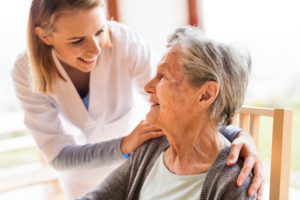 “Each patient is unique and requires a personalized approach to care,” Dora Butler, a registered nurse practitioner at Homeland, adds. “The Homeland team works together, along with a patient’s other health care providers, to ensure that care is consistent, compassionate and individualized.”
“Each patient is unique and requires a personalized approach to care,” Dora Butler, a registered nurse practitioner at Homeland, adds. “The Homeland team works together, along with a patient’s other health care providers, to ensure that care is consistent, compassionate and individualized.”
